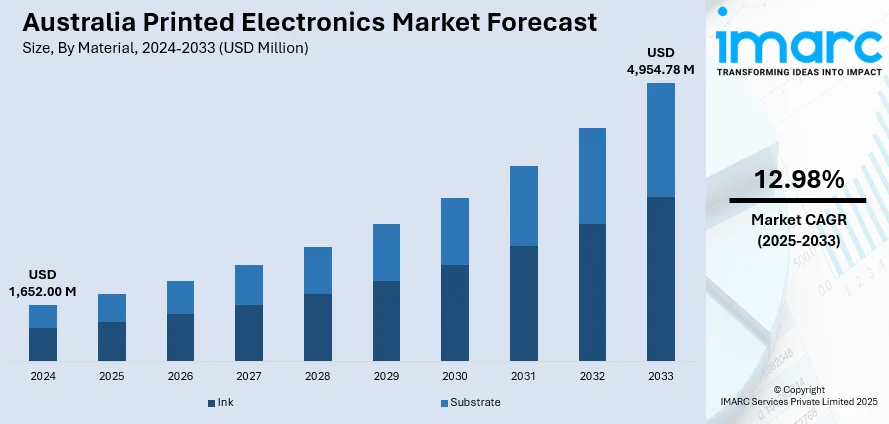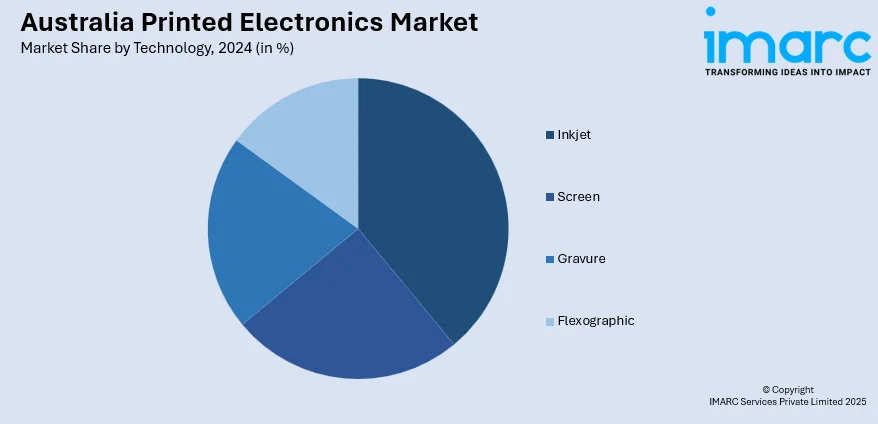
Australia Printed Electronics Market Size, Share, Trends and Forecast by Material, Technology, Device, and Region, 2025-2033
Australia Printed Electronics Market Overview:
The Australia printed electronics market size reached USD 1,652.00 Million in 2024. Looking forward, IMARC Group expects the market to reach USD 4,954.78 Million by 2033, exhibiting a growth rate (CAGR) of 12.98% during 2025-2033. The market is gaining traction due to rising demand for flexible solar panels, energy-harvesting devices, and printed sensors. Advances in R&D, public-private collaboration, and investment in scalable infrastructure are driving innovation and expanding commercial applications across multiple industries.
|
Report Attribute
|
Key Statistics
|
|---|---|
|
Base Year
|
2024 |
|
Forecast Years
|
2025-2033
|
|
Historical Years
|
2019-2024
|
| Market Size in 2024 | USD 1,652.00 Million |
| Market Forecast in 2033 | USD 4,954.78 Million |
| Market Growth Rate 2025-2033 | 12.98% |
Australia Printed Electronics Market Trends:
Expansion of Flexible Solar Technology
Australia has seen a growing interest in printed electronics, particularly in the development of flexible solar technologies. The appeal of lightweight, portable solar films has captured the attention of various sectors looking for low-impact energy solutions. These include defense, emergency services, and outdoor infrastructure. As renewable energy goals become more pressing, interest in adaptable power sources has grown. Australia’s printed electronics market share has expanded in recent years, reflecting increased investment and innovation in this sector. In October 2024, CSIRO opened a dedicated facility to produce printed solar films using perovskite-based materials. The setup uses continuous roll-to-roll printing methods that reduce production costs and support higher output. This effort bridges the gap between lab-scale research and industrial application. The technology allows deployment in areas unsuitable for conventional panels, such as curved surfaces or temporary installations. The shift signals growing commercial intent and showcases the country’s readiness to build domestic manufacturing strength in this emerging field. As industry collaboration deepens, this trend is likely to influence broader uptake of printed photovoltaic applications.

To get more information on this market, Request Sample
Innovation in Energy-Harvesting Solutions
Australia’s printed electronics space is also advancing in the field of energy harvesting, where technologies convert ambient sources like moisture into usable power. These developments aim to enable new types of low-power electronics, particularly for environments where solar or grid access is limited. In October 2024, Strategic Elements launched its Energy Ink program, focused on creating thin-film cells that extract energy from humidity. Developed in collaboration with Stealth Technologies and UNSW, this initiative transitioned from lab-scale cells to A4-sized printed sheets using automated commercial machinery. The innovation enhances scalability and aims to power lightweight devices without reliance on sunlight or batteries. As testing moves forward, the technology may serve niche needs in remote sensing, wearables, and low-energy systems. By embedding this capability into printable formats, Australian firms are creating unique pathways for decentralized energy. With rising support from research institutes and interest from niche industries, printed energy solutions could reshape how devices are powered in off-grid settings. The shift reflects a growing appetite for integrated and sustainable power alternatives.
Australia Printed Electronics Market Segmentation:
IMARC Group provides an analysis of the key trends in each segment of the market, along with forecasts at the country and regional level for 2025-2033. Our report has categorized the market based on material, technology, and device.
Material Insights:
- Ink
- Substrate
The report has provided a detailed breakup and analysis of the market based on the material. This includes ink and substrate.
Technology Insights:

- Inkjet
- Screen
- Gravure
- Flexographic
As per Australia printed electronics market outlook, a detailed breakup and analysis of the market based on the technology have also been provided in the report. This includes inkjet, screen, gravure, and flexographic.
Device Insights:
- Display
- Photovoltaic
- Lighting
- RFID
- Others
A detailed breakup and analysis of the market based on the device have also been provided in the report. This includes display, photovoltaic, lighting, RFID, and others.
Regional Insights:
- Australia Capital Territory & New South Wales
- Victoria & Tasmania
- Queensland
- Northern Territory & Southern Australia
- Western Australia
The report has also provided a comprehensive analysis of all the major regional markets, which include Australia Capital Territory & New South Wales, Victoria & Tasmania, Queensland, Northern Territory & Southern Australia, and Western Australia.
Competitive Landscape:
The market research report has also provided a comprehensive analysis of the competitive landscape. Competitive analysis such as market structure, key player positioning, top winning strategies, competitive dashboard, and company evaluation quadrant has been covered in the report. Also, detailed profiles of all major companies have been provided.
Australia Printed Electronics Market News:
- October 2024: CSIRO opened a USD 6.8 Million facility in Victoria to commercialize printed flexible solar technology. Using perovskite-based films, the development advanced printed electronics in Australia by enabling low-cost, scalable solar solutions, boosting domestic manufacturing potential and supporting renewable energy innovation.
- October 2024: Strategic Elements launched a cell-to-sheet Energy Ink program using printed electronics to generate power from moisture. The initiative scaled ultra-thin energy cells to A4 size, advancing commercial feasibility and positioning Australia as a key innovator in non-solar renewable energy solutions.
Australia Printed Electronics Market Report Coverage:
| Report Features | Details |
|---|---|
| Base Year of the Analysis | 2024 |
| Historical Period | 2019-2024 |
| Forecast Period | 2025-2033 |
| Units | Million USD |
| Scope of the Report |
Exploration of Historical Trends and Market Outlook, Industry Catalysts and Challenges, Segment-Wise Historical and Future Market Assessment:
|
| Materials Covered | Ink, Substrate |
| Technologies Covered | Inkjet, Screen, Gravure, Flexographic |
| Devices Covered | Display, Photovoltaic, Lighting, RFID, Others |
| Regions Covered | Australia Capital Territory & New South Wales, Victoria & Tasmania, Queensland, Northern Territory & Southern Australia, Western Australia |
| Customization Scope | 10% Free Customization |
| Post-Sale Analyst Support | 10-12 Weeks |
| Delivery Format | PDF and Excel through Email (We can also provide the editable version of the report in PPT/Word format on special request) |
Key Questions Answered in This Report:
- How has the Australia printed electronics market performed so far and how will it perform in the coming years?
- What is the breakup of the Australia printed electronics market on the basis of material?
- What is the breakup of the Australia printed electronics market on the basis of technology?
- What is the breakup of the Australia printed electronics market on the basis of device?
- What is the breakup of the Australia printed electronics market on the basis of region?
- What are the various stages in the value chain of the Australia printed electronics market?
- What are the key driving factors and challenges in the Australia printed electronics market?
- What is the structure of the Australia printed electronics market and who are the key players?
- What is the degree of competition in the Australia printed electronics market?
Key Benefits for Stakeholders:
- IMARC’s industry report offers a comprehensive quantitative analysis of various market segments, historical and current market trends, market forecasts, and dynamics of the Australia printed electronics market from 2019-2033.
- The research report provides the latest information on the market drivers, challenges, and opportunities in the Australia printed electronics market.
- Porter's five forces analysis assist stakeholders in assessing the impact of new entrants, competitive rivalry, supplier power, buyer power, and the threat of substitution. It helps stakeholders to analyze the level of competition within the Australia printed electronics industry and its attractiveness.
- Competitive landscape allows stakeholders to understand their competitive environment and provides an insight into the current positions of key players in the market.
Need more help?
- Speak to our experienced analysts for insights on the current market scenarios.
- Include additional segments and countries to customize the report as per your requirement.
- Gain an unparalleled competitive advantage in your domain by understanding how to utilize the report and positively impacting your operations and revenue.
- For further assistance, please connect with our analysts.
 Request Customization
Request Customization
 Speak to an Analyst
Speak to an Analyst
 Request Brochure
Request Brochure
 Inquire Before Buying
Inquire Before Buying




.webp)




.webp)












